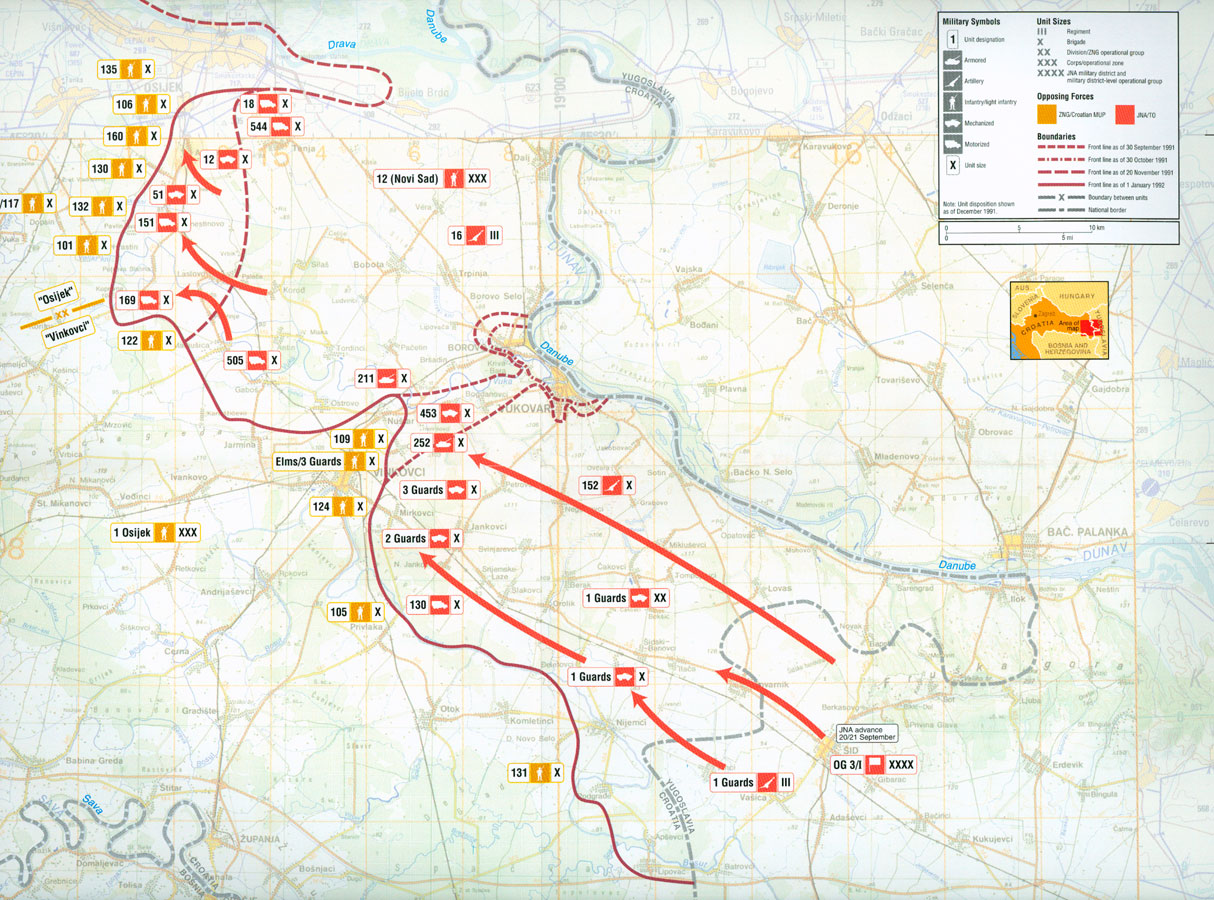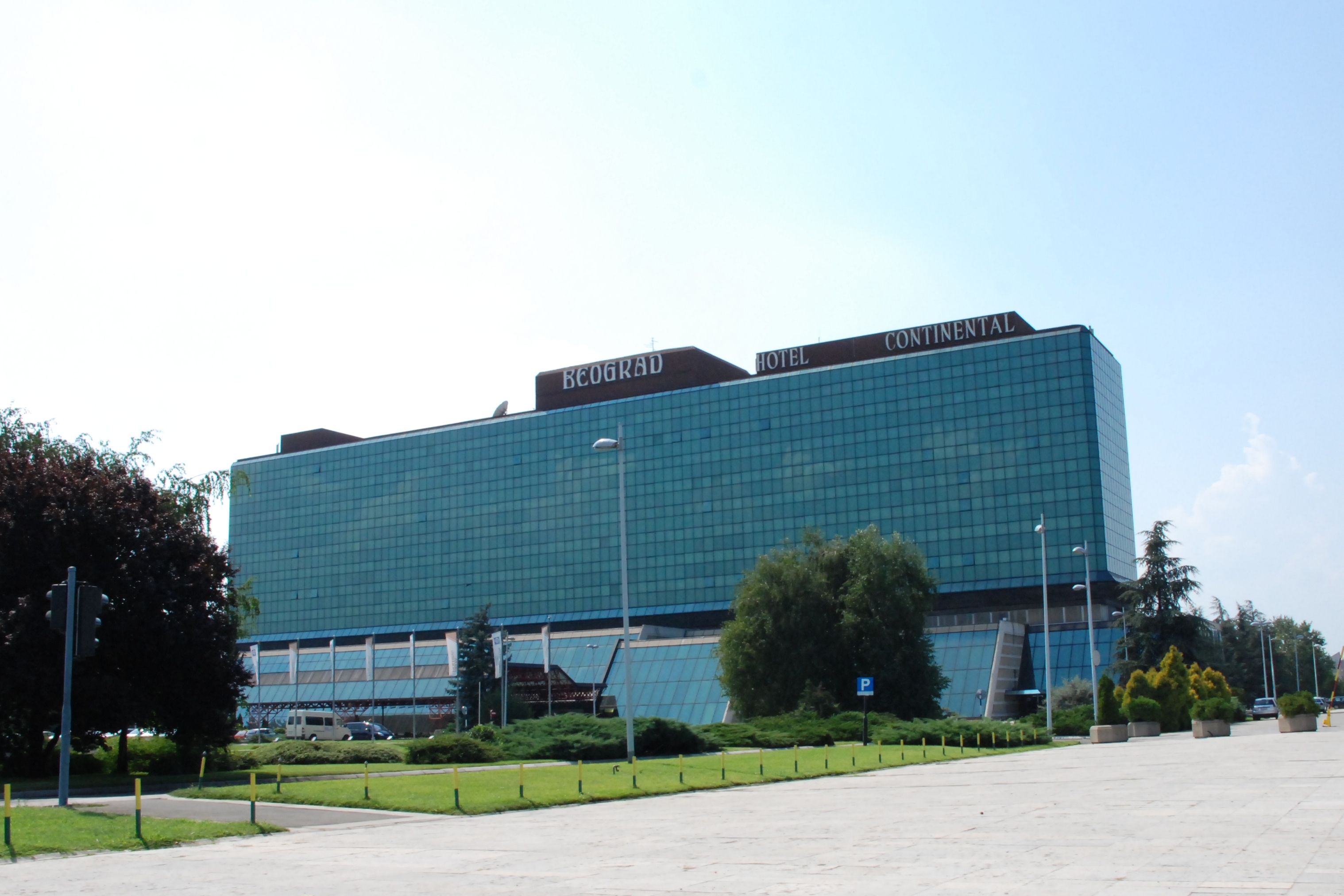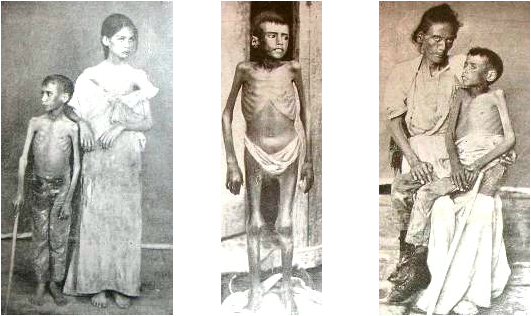|
Ovčara Camp
Ovčara was a Serbian transit camp for Croatian prisoners during the Croatian War of Independence, from October to December 1991, and the location of the Ovčara massacre. Prison camp Ovčara is located 5 kilometers southeast of the city of Vukovar. It is a desolate stretch of land where the Vukovar agricultural conglomerate built cattle-raising facilities after World War II. These facilities are storage hangars, which are fenced and can be easily guarded. The hangars are made of brick and have a big sliding front door, which includes a small door. The Serbian forces turned Ovčara into a prison camp in early October 1991. Aside from the massacre, 3,000 to 4,000 men prisoners were temporarily held in the camp before being transported to the prison in Sremska Mitrovica or to the local army barracks, which was the transit point for the Serbian detention camps Stajićevo, Begejci and others. Some of the Serb forces were led by Željko Ražnatović "Arkan" who directed much of ... [...More Info...] [...Related Items...] OR: [Wikipedia] [Google] [Baidu] |
Grabovo, Croatia
Grabovo is a place south of Vukovar, Croatia. It consists of two hamlets, Ovčara and Jakobovac, in the north, which are administratively part of the city of Vukovar, and have a total population of 47, and an uninhabited section in the south which is administratively under the municipality of Tompojevci. Ovčara is best known for the Ovčara camp and the Ovčara massacre of 1991. Ovčara and Jakobovac each used to be registered as a standalone settlement Settlement may refer to: *Human settlement, a community where people live *Settlement (structural), the distortion or disruption of parts of a building * Closing (real estate), the final step in executing a real estate transaction *Settlement (fin ..., but were joined under the name Grabovo in 1991, and subsequently administratively split in 2001. References {{VukovarSyrmia-geo-stub Populated places in Vukovar-Syrmia County ... [...More Info...] [...Related Items...] OR: [Wikipedia] [Google] [Baidu] |
Internment Camp
Internment is the imprisonment of people, commonly in large groups, without charges or intent to file charges. The term is especially used for the confinement "of enemy citizens in wartime or of terrorism suspects". Thus, while it can simply mean imprisonment, it tends to refer to preventive confinement rather than confinement ''after'' having been convicted of some crime. Use of these terms is subject to debate and political sensitivities. The word ''internment'' is also occasionally used to describe a neutral country's practice of detaining belligerent armed forces and equipment on its territory during times of war, under the Hague Convention of 1907. Interned persons may be held in prisons or in facilities known as internment camps (also known as concentration camps). The term ''concentration camp'' originates from the Spanish–Cuban Ten Years' War when Spanish forces detained Cuban civilians in camps in order to more easily combat guerrilla forces. Over the following dec ... [...More Info...] [...Related Items...] OR: [Wikipedia] [Google] [Baidu] |
Serbian Concentration Camps In The Yugoslav Wars
Serbian may refer to: * someone or something related to Serbia, a country in Southeastern Europe * someone or something related to the Serbs, a South Slavic people * Serbian language * Serbian names See also * * * Old Serbian (other) * Serbians * Serbia (other) * Names of the Serbs and Serbia Names of the Serbs and Serbia are terms and other designations referring to general terminology and nomenclature on the Serbs ( sr, Срби, Srbi, ) and Serbia ( sr, Србија/Srbija, ). Throughout history, various endonyms and exonyms have bee ... {{Disambiguation Language and nationality disambiguation pages ... [...More Info...] [...Related Items...] OR: [Wikipedia] [Google] [Baidu] |
Prisoner Of War
A prisoner of war (POW) is a person who is held captive by a belligerent power during or immediately after an armed conflict. The earliest recorded usage of the phrase "prisoner of war" dates back to 1610. Belligerents hold prisoners of war in custody for a range of legitimate and illegitimate reasons, such as isolating them from the enemy combatants still in the field (releasing and repatriating them in an orderly manner after hostilities), demonstrating military victory, punishing them, prosecuting them for war crimes, exploiting them for their labour, recruiting or even conscripting them as their own combatants, collecting military and political intelligence from them, or indoctrinating them in new political or religious beliefs. Ancient times For most of human history, depending on the culture of the victors, enemy fighters on the losing side in a battle who had surrendered and been taken as prisoners of war could expect to be either slaughtered or enslaved. Ear ... [...More Info...] [...Related Items...] OR: [Wikipedia] [Google] [Baidu] |
Mass Grave
A mass grave is a grave containing multiple human corpses, which may or may not be identified prior to burial. The United Nations has defined a criminal mass grave as a burial site containing three or more victims of execution, although an exact definition is not unanimously agreed upon. Mass graves are usually created after many people die or are killed, and there is a desire to bury the corpses quickly for sanitation concerns. Although mass graves can be used during major conflicts such as war and crime, in modern times they may be used after a famine, epidemic, or natural disaster. In disasters, mass graves are used for infection and disease control. In such cases, there is often a breakdown of the social infrastructure that would enable proper identification and disposal of individual bodies. History Mass or communal burial was a common practice before the development of a dependable crematory chamber by Ludovico Brunetti in 1873. In ancient Rome waste and dead bodies of the ... [...More Info...] [...Related Items...] OR: [Wikipedia] [Google] [Baidu] |
Vukovar Hospital Massacre
The Vukovar massacre, also known as the Vukovar hospital massacre or the Ovčara massacre, was the killing of Croatian prisoners of war and civilians by Serb paramilitaries, to whom they had been turned over by the Yugoslav People's Army (JNA), at the Ovčara farm southeast of Vukovar on 20 November 1991, during the Croatian War of Independence. The massacre occurred shortly after Vukovar's capture by the JNA, Territorial Defence (TO), and paramilitaries from neighbouring Serbia. It was the largest massacre of the Croatian War of Independence. In the final days of the battle, the evacuation of the Vukovar hospital was negotiated between Croatian authorities, the JNA and the European Community Monitor Mission in cooperation with the International Committee of the Red Cross (ICRC). The JNA subsequently refused the ICRC access to the hospital despite the agreement and removed approximately 300 people from its premises. The group, largely consisting of Croats but also including S ... [...More Info...] [...Related Items...] OR: [Wikipedia] [Google] [Baidu] |
Battle Of Vukovar
The Battle of Vukovar was an 87-day siege of Vukovar in eastern Croatia by the Yugoslav People's Army (JNA), supported by various paramilitary forces from Serbia, between August and November 1991. Before the Croatian War of Independence the Baroque town was a prosperous, mixed community of Croats, Serbs and other ethnic groups. As Yugoslavia began to break up, Serbia's President Slobodan Milošević and Croatia's President Franjo Tuđman began pursuing nationalist politics. In 1990, an armed insurrection was started by Croatian Serb militias, supported by the Serbian government and paramilitary groups, who seized control of Serb-populated areas of Croatia. The JNA began to intervene in favour of the rebellion, and conflict broke out in the eastern Croatian region of Slavonia in May 1991. In August, the JNA launched a full-scale attack against Croatian-held territory in eastern Slavonia, including Vukovar. Vukovar was defended by around 1,800 lightly armed soldiers of the Croat ... [...More Info...] [...Related Items...] OR: [Wikipedia] [Google] [Baidu] |
Željko Ražnatović
Željko Ražnatović (, ; 17 April 1952 – 15 January 2000), better known as Arkan (), was a Serbian mobster, politician, sports administrator, paramilitary commander and head of the Serb paramilitary force called the Serb Volunteer Guard during the Yugoslav Wars. He was on Interpol's most wanted list in the 1970s and 1980s for robberies and murders committed in a number of countries across Europe, and was later indicted by the International Criminal Tribunal for the former Yugoslavia for crimes against humanity. Up until his assassination in January 2000, Ražnatović was the most powerful organized crime figure in the Balkans. Early life Željko Ražnatović was born in Brežice, a small border town in Lower Styria, PR Slovenia, FPR Yugoslavia. His father Veljko, was born in Rijeka Crnojevića near Cetinje, and had taken part in the Partisan liberation of Priština (Kosovo) during World War II. Later on, Veljko served as a decorated officer in the SFR-Yugoslav Air ... [...More Info...] [...Related Items...] OR: [Wikipedia] [Google] [Baidu] |
Begejci Camp
The Begejci camp (''Logor Begejci'') was a detention camp established in September–October 1991 in Begejci near Zrenjanin, Serbia (then part of SFR Yugoslavia, then FRY) where Croatian prisoners of war and civilians were kept by Serbian authorities during the Croatian War of Independence. The detainees were mostly brought from Vukovar and some were later moved to other camps. At east three people are known to have died there.Final report of the United Nations Commission of Experts, established pursuant to security council resolution 780 (1992), Annex VIII - Prison camps; Under the Direction of: M. Cherif Bassiouni; S/1994/674/Add.2 (Vol. IV), 27 May 199''Annex VIII: Prison camps (part 10/10) - Begejci'' (p. 5481). The camp was opened in the autumn of 1991, and held approximately 600 prisoners. The ICTY cited 260 detainees in its indictment against Slobodan Milošević. In December 1991, approximately 300 prisoners were returned to Croatia as part of a prisoner exchange. Priso ... [...More Info...] [...Related Items...] OR: [Wikipedia] [Google] [Baidu] |
Stajićevo Camp
The Stajićevo camp (''Logor Stajićevo'') was an agricultural farm in Stajićevo near Zrenjanin, Serbia (then part of SFR Yugoslavia, then FRY) where Croatian prisoners of war and civilians were kept by Serbian authorities. The camp also acted as a transit facility where prisoners were taken before being moved to the Sremska Mitrovica camp. Individual reports have said that 1500 people were held there.Final report of the United Nations Commission of Experts established pursuant to security council resolution 780 The ICTY's figure for the camp was 1700 detainees. The camp was cited in the |
Detention Camp
Internment is the imprisonment of people, commonly in large groups, without charges or intent to file charges. The term is especially used for the confinement "of enemy citizens in wartime or of terrorism suspects". Thus, while it can simply mean imprisonment, it tends to refer to preventive confinement rather than confinement ''after'' having been convicted of some crime. Use of these terms is subject to debate and political sensitivities. The word ''internment'' is also occasionally used to describe a neutral country's practice of detaining belligerent armed forces and equipment on its territory during times of war, under the Hague Convention of 1907. Interned persons may be held in prisons or in facilities known as internment camps (also known as concentration camps). The term ''concentration camp'' originates from the Spanish–Cuban Ten Years' War when Spanish forces detained Cuban civilians in camps in order to more easily combat guerrilla forces. Over the following dec ... [...More Info...] [...Related Items...] OR: [Wikipedia] [Google] [Baidu] |
Sremska Mitrovica Camp
Sremska Mitrovica Prison (Serbian: Казнено-поправни завод у Сремској Митровици / ''Kazneno-popravni zavod u Sremskoj Mitrovici'') is the biggest prison in Serbia, consisting of two facilities. It is situated in Sremska Mitrovica, Vojvodina province. During the Yugoslavian Civil Wars it was used as a concentration camp for thousands of Croatian and Bosnian prisoners amidst allegations of torture, prisoner abuse and rape. History Foundation and early history It was formed by the order of Habsburg emperor Franz Joseph between 1895 and 1899. From 1918 to 1941, it functioned under administration of the Kingdom of Yugoslavia and after 1944 under administration of the Socialist Federal Republic of Yugoslavia. Yugoslav Wars During Yugoslav Wars, some Croatian prisoners of war were kept in this prison. The main prison facility; the largest known in Serbia, was open from November 1991 to August 1992 and was a scene where many prisoners were tortured, ab ... [...More Info...] [...Related Items...] OR: [Wikipedia] [Google] [Baidu] |





